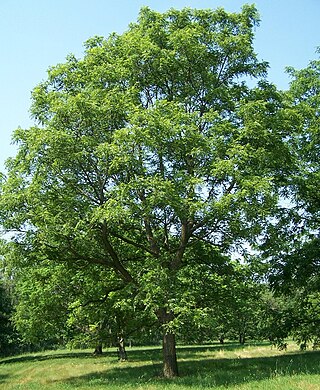
Walnut trees are any species of tree in the plant genus Juglans, the type genus of the family Juglandaceae, the seeds of which are referred to as walnuts. All species are deciduous trees, 10–40 metres (33–131 ft) tall, with pinnate leaves 200–900 millimetres (7.9–35.4 in), with 5–25 leaflets; the shoots have chambered pith, a character shared with the wingnuts (Pterocarya), but not the hickories (Carya) in the same family.
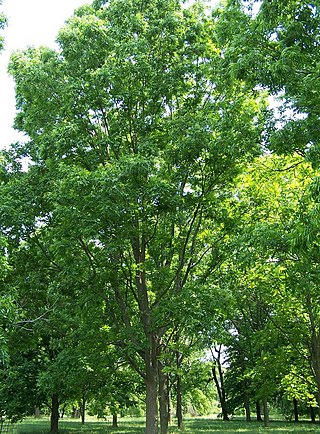
The pecan is a species of hickory native to the southern United States and northern Mexico in the region of the Mississippi River.

The Juglandaceae are a plant family known as the walnut family. They are trees, or sometimes shrubs, in the order Fagales. Members of this family are native to the Americas, Eurasia, and Southeast Asia.

Hickory is a common name for trees composing the genus Carya, which includes around 18 species. Five or six species are native to China, Indochina, and India (Assam), as many as twelve are native to the United States, four are found in Mexico, and two to four are native to Canada. A number of hickory species are used for their edible nuts, lumber or other wood and woodcraft products.

Pterocarya, often called wingnuts in English, are trees in the walnut family Juglandaceae. They are native to Asia. The botanic name is from Ancient Greek πτερον (pteron) "wing" + κάρυον (karyon) "nut".

Juglandeae is a tribe of the Juglandoideae subfamily, in the Juglandaceae family.
Carya sinensis is a species of tree native to southwestern China and northern Vietnam, in the hickory genus Carya. It is sometimes called Chinese hickory or beaked hickory. It is closely related to Carya kweichowensis.
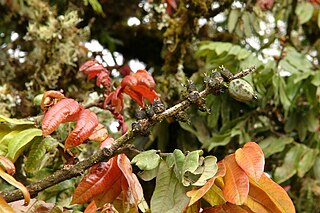
Alfaroa is a genus of evergreen trees in the Juglandaceae family of the Fagales, growing in montane and submontane tropical rain forests in Central America. The wood is characterized by solid pith, pink heartwood, and vessels with scalariform perforations, as well as simple perforations.

Oreomunnea pterocarpa, known locally as gavilán or gavilán blanco, is a species of Oreomunnea in the family Juglandaceae. It is found in Costa Rica, southeastern Mexico (Chiapas), and Panama.
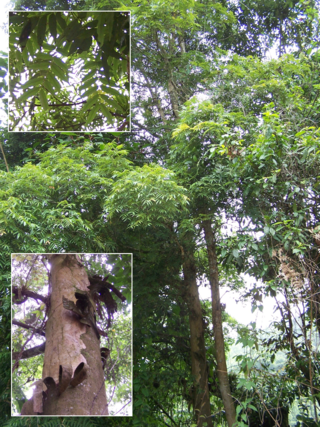
Oreomunnea is a genus of two species of flowering plants in the family Juglandaceae, native to southern Mexico and Central America, where they occur in montane rainforest.
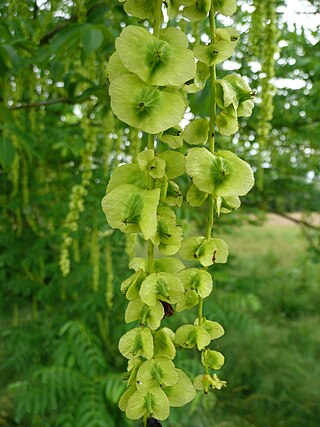
Pterocarya fraxinifolia is a species of tree in the Juglandaceae family. It is commonly known as the Caucasian wingnut or Caucasian walnut. It is native to the Caucasian region Armenia, Azerbaijan, Georgia, Iran, Russia, Ukraine and Turkey. It was introduced to France in 1784, and to Great Britain after 1800.

Cyclocarya is a genus of flowering plants in the family Juglandaceae, comprising a single species Cyclocarya paliurus, formerly treated in the genus Pterocarya as Pterocarya paliurus. It is native to eastern and central China.

Platycarya is a genus of flowering plants in the family Juglandaceae native to eastern Asia in China, Korea, and Japan.

Platycarya strobilacea is a species of flowering plant in the family Juglandaceae, formerly treated as comprising the single living species in Platycarya, though a second living species Platycarya longzhouensis is now recognized. It is native to eastern Asia in China, Vietnam, Korea, and Japan.

Pterocarya rhoifolia, commonly known as Japanese wingnut, is a species of tree in the family Juglandaceae. It is widely distributed throughout Japan, and also found in China in the Laoshan District of eastern Shandong Province. Its natural presence in China is contested.
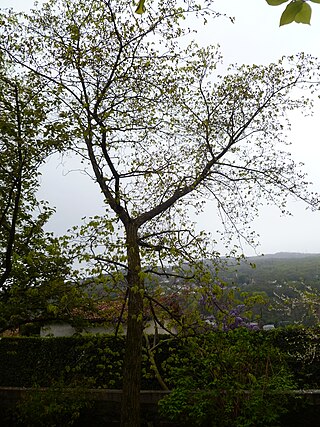
Platycaryeae is a tribe of flowering plants in the family Juglandaceae, and comprising a single living genus Platycarya. The tribe is now native to eastern Asia in China, Korea, and Japan.

Juglandinae is a subtribe of the Juglandeae tribe, of the Juglandoideae subfamily, in the Juglandaceae family. Walnut tree species make up the genus Juglans, which belongs to the subtribe Juglandinae.
Carya hunanensis is a species of hickory native to China. It was first described by Wan Chun Cheng and R.H. Chang. Carya hunanensis is part of the genus Carya, and the family Juglandaceae. No subspecies are listed in the Catalog of Life.
Carya poilanei is a very large species of hickory native to northern Laos, northern Vietnam, Thailand, and southern China. It was first described by Auguste Jean Baptiste Chevalier, and given its current name by André Leroy. Carya poilanei is part of the genus Carya, and the family Juglandaceae.
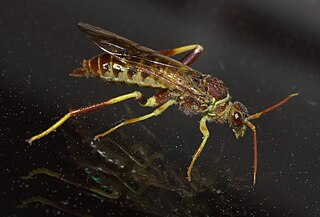
Megaxyela is a genus of sawflies in the family Xyelidae. There are about 13 described species in Megaxyela, found in the eastern Nearctic and in the southeastern part of East Asia. Two fossil species have been discovered, in Colorado and Shandong, China.















